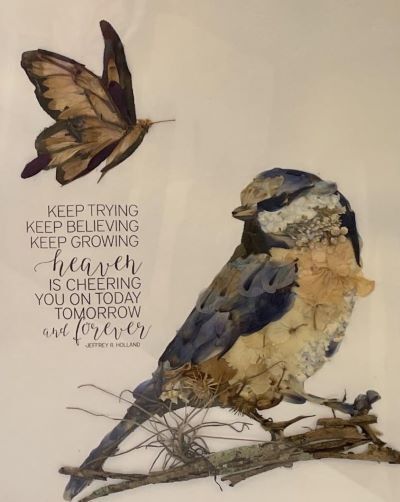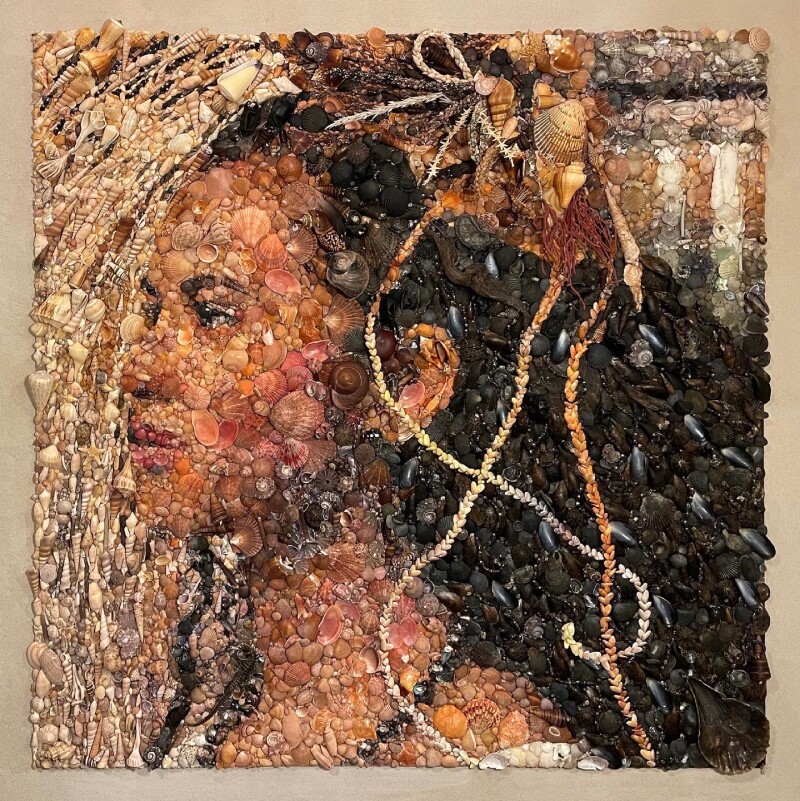Artist Shelby Stroud’s most famous piece of artwork all started with an overgrown garden.
As Shelby pulled weeds in the backyard of her home near St. Louis, Missouri, she uncovered what she called a “whole secret garden”—hundreds of river rocks that had been hidden under the weeds and overgrowth.
She began casually arranging the rocks by shade while her kids went swimming in the backyard pool. In the months that followed, she found herself drawn to the rocks, arranging them into an ombré effect or into simple patterns that resembled a seashore.

“I found that I wanted to be out there doing that all the time,” Shelby says. “If I was on a stressful phone call or something, I wouldn’t even notice myself walking outside and kneeling down on the rocks and moving them around.”
Eventually, it grew too cold for Shelby to spend much time outside, and she set the stones aside. But she wasn’t ready to give up her new art form, and she started searching her house for something she could use to continue creating. That’s when she looked at the jars and buckets full of the thousands of seashells she had collected throughout her life, and a lightbulb went on in her mind—could she arrange the seashells like she had arranged the river rock? But instead of simple patterns, Shelby wondered if she could create detailed, realistic portraits.
As it turns out, she could—and the result was stunning.
“I tried one just for fun. I had no expectations,” Shelby says of her first shell portrait, which she started in November 2020 and finished by the end of that year. “It was a picture of my daughter, and it’s still my favorite one. After that, I was hooked.”
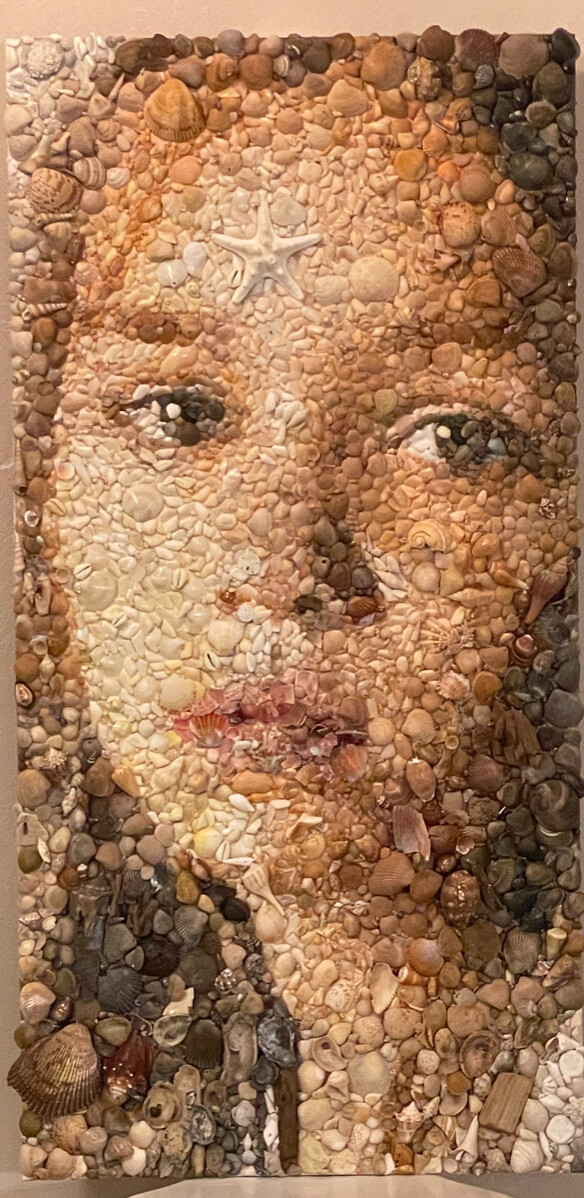
Since then, Shelby has fallen in love with creating shell portraits. She has finished four more pieces, including one that has recently been on display at the Church History Museum as part of its 12th International Art Competition. The piece was only the third shell portrait Shelby had ever completed—but it was still one of just 148 pieces accepted to the competition out of 859 artworks submitted. Her art has since been seen and celebrated by hundreds of thousands of people, both through the exhibit and online. While that experience has been gratifying, the process has also been profoundly personal, enabling Shelby to understand the gospel on a deeper level and find healing and peace during her own trials.
Treasure Trove of Shells
Shelby, who grew up in Phoenix, Arizona, says one of her earliest memories is searching for seashells while on vacation in Dana Point, California. She found an abalone shell, a type known for its exceptional beauty and iridescent qualities, and still remembers her dad’s surprise and amazement upon seeing her newfound treasure. Ever since, Shelby has loved to collect shells, rocks, driftwood, and feathers.
In addition to collecting, Shelby has always been a creator at heart. As a girl, she loved to draw, and her entire life she’s doodled, sketched, painted, sculpted, created mosaic art, and “dabbled in all things arts and crafts.” She’s also sold painted peg dolls, sculpted a Sharknado-style tornado of sharks that hung from her ceiling for Shark Week, won T-shirt design contests and learned to form the shape of a cat out of a Starburst candy in 30 seconds flat.
After studying art at Southern Utah University, Shelby worked as a graphic designer for more than a decade. When she decided to stop working to stay home with her kids, she made art as gifts, while helping her kids with their school projects, or simply for the sake of creating.
Shelby moved with her family to the St. Louis, Missouri, area in May 2004. It was in their new ward that she met Mami Young, who became her best friend and shelling partner. Even though they lived in the Midwest, the friends fostered their shared love of the ocean by taking shelling trips together along the Gulf Coast. They would walk along the beach for hours collecting seashells. Shelby amassed jars and eventually shelves full of seashells in her storage room, and she still loved to go out and find new shells for her collection—but neither she nor Mami considered that her growing treasure trove would lead to Shelby discovering another passion.
Mami couldn’t believe her eyes when Shelby showed her the first shell portrait. Like all of Shelby’s friends and family, she was stunned by the detail and beauty of the portrait, which captured every element of her daughter perfectly, duplicating not only the shape of her eyes, nose, and mouth but also capturing the emotion in her face.
For Mami, just as beautiful as the artwork itself has been the experience of watching her best friend discover her passion, especially after dedicating so much of her life to her five children.
“She’d been a mom for so long, and … this was the first thing she’d done for herself in a while,” Mami says. “So it’s really fun to watch her get to shine as herself: not as ‘Mom,’ but as Shelby.”

Mami loves to see the shells she helped collect come together in Shelby’s portraits and says it’s been “joyous” to see Shelby’s success.
“The fun thing is watching her work,” Mami says. “She can get lost in it for hours, not even breathe—just work and work because she’s just passionate about it.”
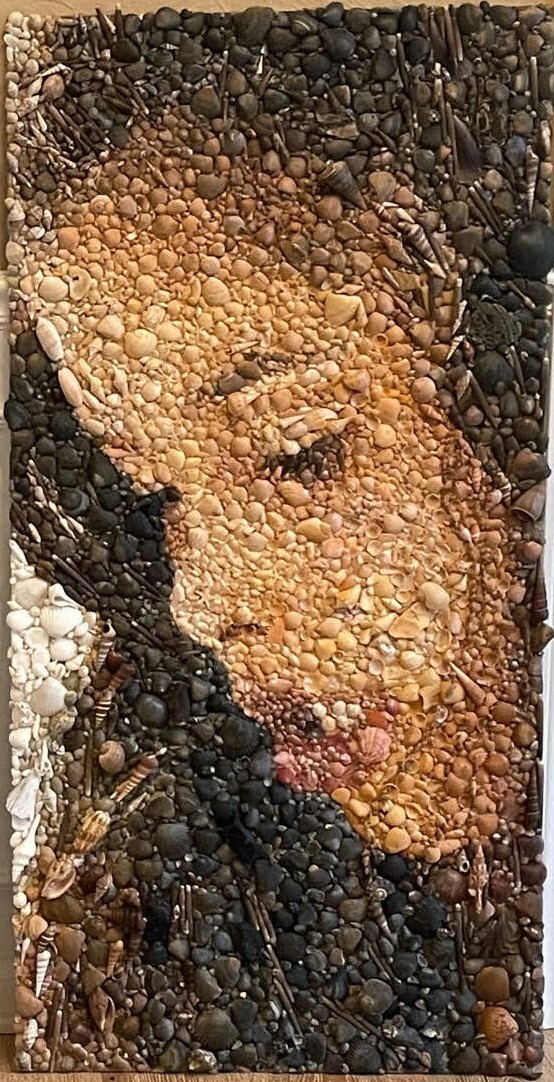
Falling for Art
As Shelby’s kids have grown older, she’s had more time to create. Her almost accidental discovery of shell portraits has pushed art to the forefront of her life.
“It’s kind of like falling in love with your best friend,” Shelby says. “Art has always been around me. It’s always brought me joy. It’s always been a comfort. But when I … started doing these [shell portraits], I finally looked [at] it and realized, ‘Oh my gosh, I love you.’ I love art. I love doing this. This is where my joy is. This is where I want to be. It’s always been there; I just never realized what it could be for me.”
Shelby creates each shell portrait primarily with shells she and her loved ones have collected. This became much easier when she and her family moved from St. Louis to Jacksonville, Florida, in 2021. Shelby, who describes herself as “ocean-obsessed,” had started looking for job listings for her husband in Florida “just for fun”— she dreamed of finding a reason to move her family closer to the sea. To her surprise, a job did materialize, and within a few months, the Strouds moved to Florida.
Now, instead of having to rely on occasional shelling trips, Shelby goes to the beach weekly to expand her collection. Once the shells are cleaned and sorted, she begins by drawing a rough outline of a portrait based on a photograph. Then she starts placing the shells to bring her portrait to life.
“I climb up on a stool every once in a while and take a picture with my phone up above my head and then climb back down and look at it to see if it’s working,” Shelby says. “Then I’ll rework it and change it. I’ll usually lay out a section of shells until I get them how I like and then glue them down. But I’m climbing up and down and off the stool a thousand times.”
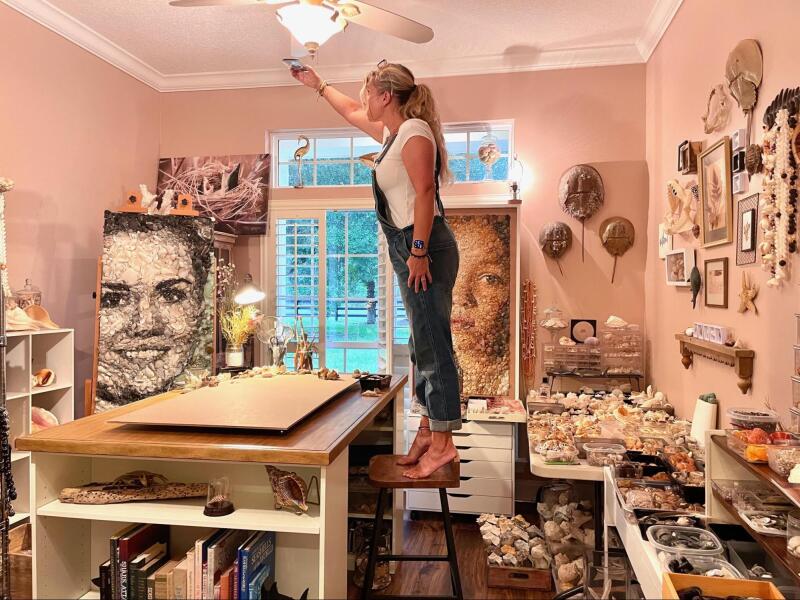
Shelby’s method for capturing intricate details, precise shading, and even emotions in her shell portraits is surprisingly simple: “It’s pretty much by eyeballing it,” she says, adding that she also compares the portrait to the inspiration photo. She never colors her shells, choosing to form every portrait with the shells’ natural beauty.
Each shell portrait requires thousands of shells and more than 100 hours of work. But for Shelby, it’s anything but a chore. “It goes by so fast,” she says. “I could do it all day and all night and never get tired and never even notice that time is going by.”
The process of collecting, arranging, and gluing thousands of small shells to create a portrait hasn’t just been artistically fulfilling for Shelby—it’s also been a spiritual exercise, teaching her in a very literal way that “by small and simple things are great things brought to pass” (Alma 37:6).
A similar quote by Vincent van Gogh has inspired Shelby in her work. The Post-Impressionist artist said that great things come about through “a succession of little things that are brought together.”
“In a similar way, I love watching how my small shells come together to make something great,” Shelby says.
The same principle reminds Shelby of her experience as a mother. She has five children, three of whom still live at home with her. She remembers being a young mother and doing small things every day that didn’t seem to make a big difference. However, just as with her shell portraits, the small things worked together to form a bigger picture.
“Really, it’s kind of like placing these little shells,” she says. “You do it all day, every day, over the course of your life, and at the end, you have this beautiful thing that you’ve created in your family.”
International Art Competition
With the encouragement of friends and family, Shelby decided to create a shell portrait to submit to the Church History Museum’s 12th International Art Competition. Her inspiration for the piece came shortly after she began studying the competition’s theme, “All Are Alike Unto God” (see 2 Nephi 26:33).
“I was reading the scripture and the scriptures around it, and it really stuck out to me when it said, ‘I remember those who are upon the isles of the sea,’” Shelby says, referring to 2 Nephi 29:7. “I just knew that was what I wanted to focus on.”
Shelby found inspiration for her piece from a photo published by Deseret News of a young woman celebrating the reopening of the Laie Hawaii Temple in 2010. Shelby bought the rights to the photo and spent weeks creating the shell portrait, which she aptly titled I Remember Those Who Are on the Isles of the Sea.
The people on the “isles of the sea” have always been significant to Shelby and her family. Her husband served a full-time mission in French Polynesia, which Shelby has since visited with him, and her mother served a mission at the Polynesian Cultural Center in Hawaii. Many of the shells in Shelby’s portrait came from leis that the Polynesian people gifted her husband with before he returned home from his mission.
“When I was making it, there would be the perfect spot for a shell that was one of my treasures. And I would be like, ‘No, I can’t give it up; it’s one of my special ones,’ but it would fit so perfectly that I would just say, ‘It’s for the Lord. I can give Him a shell. It’s OK,” Shelby says.
The final piece contains more than 25,000 shells and required 190 hours to create. When she heard the news that her piece had been accepted as a finalist, Shelby couldn’t believe it.
“Even though I’ve always done art, I’d never really thought of myself as an artist,” Shelby says. “When I made it to the second round [of the competition], which is all I wanted, it was so validating. It just meant everything to me.”
After she made it through the first round of the competition, Shelby drove her piece from St. Louis to Salt Lake City for the final round of judging. On the way to Salt Lake City, a piece of sheet metal flew off the truck in front of Shelby and shattered her windshield. Fortunately, Shelby walked away uninjured, but as her car was repaired, all she could think about was the portrait, which was still inside.
“It was July and it was so hot,” Shelby says. “They had the car out in this garage, and they were working on it, and I was so worried about the portrait, because I thought, ‘What if the adhesive melts?’ It was just terrible.”
But the portrait made it unharmed to Salt Lake City, where the jury selected it as one of 148 pieces from the competition to be shown at the Church History Museum from March 17, 2022, through March 4, 2023. While on exhibit, Shelby’s piece resonated so much with viewers that it was also one of six pieces to win a visitors’ choice award.
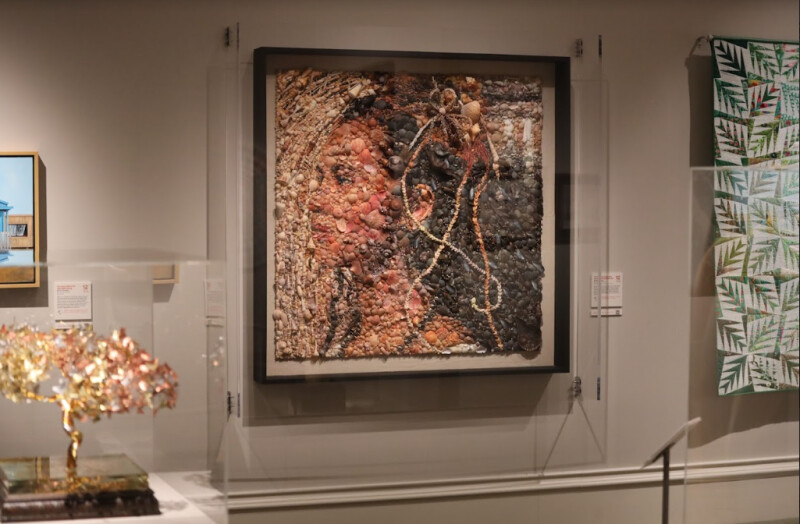
As a Church History Museum curator, Laura Howe has seen the impact of Shelby’s art on several levels.
“Shelby’s work has been a favorite among visitors to the gallery,” Laura says. “Up close, visitors are impressed by the individual shells, which are beautiful in their variety. But it is when they step back from the work and they see those shells resolve into a figure that they are overwhelmed by the beauty in the composition.” Laura believes this experience can help viewers ponder an important truth.
“The competition focuses on Nephi’s witness that ‘all are alike unto God.’ That theme begs the viewer to consider God’s perspective of humanity. … In life, individuals tend to be overwhelmed by their own experience and their own biases—just as up close, viewers can only see the seashells. But when a viewer steps back, they are put in the position of Deity, who sees how those individuals and their perspectives contribute to a cohesive whole.”
► You may also like: See the stunning winners of the Church’s International Art Competition
The Healer’s Art
While Shelby’s shell portraits are certainly an artistic accomplishment, the experience has also been a deeply personal and spiritual one for her as she’s recognized the Lord’s hand in every aspect of her art.
“Any success that I’ve had with this can be one hundred percent attributed to the Lord,” Shelby says. “The things I use, the Lord made. The ideas come from Him. The time that I get to work on it, the support that I have—I just feel so blessed.”
Shelby’s art has also been a healing balm for her, helping her feel connected to those she portrays and process the difficult things that may happen to them. Recently, she created a shell portrait of her sister-in-law, Brittany, who was dying from cancer. Creating the piece helped Shelby process her feelings of grief, and she was grateful to give her sister-in-law the portrait before her passing.
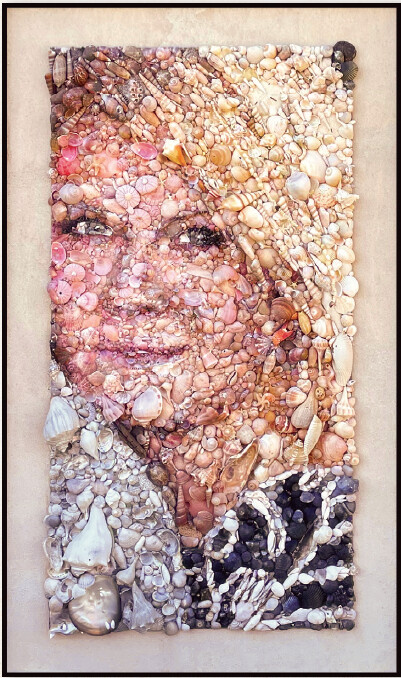
“You really see somebody when you spend that time studying them. It just makes me feel closer,” Shelby says. “I don’t understand why so many people have to suffer so much. It just feels like it’s too much sometimes. So I think [art] is a way for me to work through it and process those things.”
The healing power of Shelby’s art reaches beyond Shelby as the artist. Her sister, Melanie Stroud, had felt healing from Shelby’s art long before she ever created shell portraits. Melanie recalls that while going through a tumultuous period in her life, she saw a beautiful wheat field and experienced a moment of peace. After sharing this experience with Shelby, the next thing Melanie knew, her sister had painted and framed a picture of wheat for her. And when Melanie was raising three young children in the gospel on her own following her divorce, Shelby sculpted her a mother quail with three chicks following her lead.

“She’s used [her] art in a healing way for me,” Melanie says. “It’s not just, ‘Oh, look, I can paint a picture,’ but, ‘How can I touch somebody with my art? How can I heal somebody’s hurt with my art?’”
Melanie also remembers Shelby creating a dozen beautiful birds out of pressed flowers used for Brittany’s funeral since she went by the nickname “Bird.” For Melanie, these pieces not only capture the healing nature of Shelby’s art but also her ability to see the beauty in anything: whether it be dried flowers, seashells, torn bits of paper, or even river rock in an overgrown garden.
“I wouldn’t look at those flowers and see them as anything besides flowers,” Melanie says. “Maybe that’s the story of [Shelby’s] life: she looks past our faults. She sees me as not just this person, but this wonderful creation. I think that’s a gift that she can find the beautiful in anything.”
